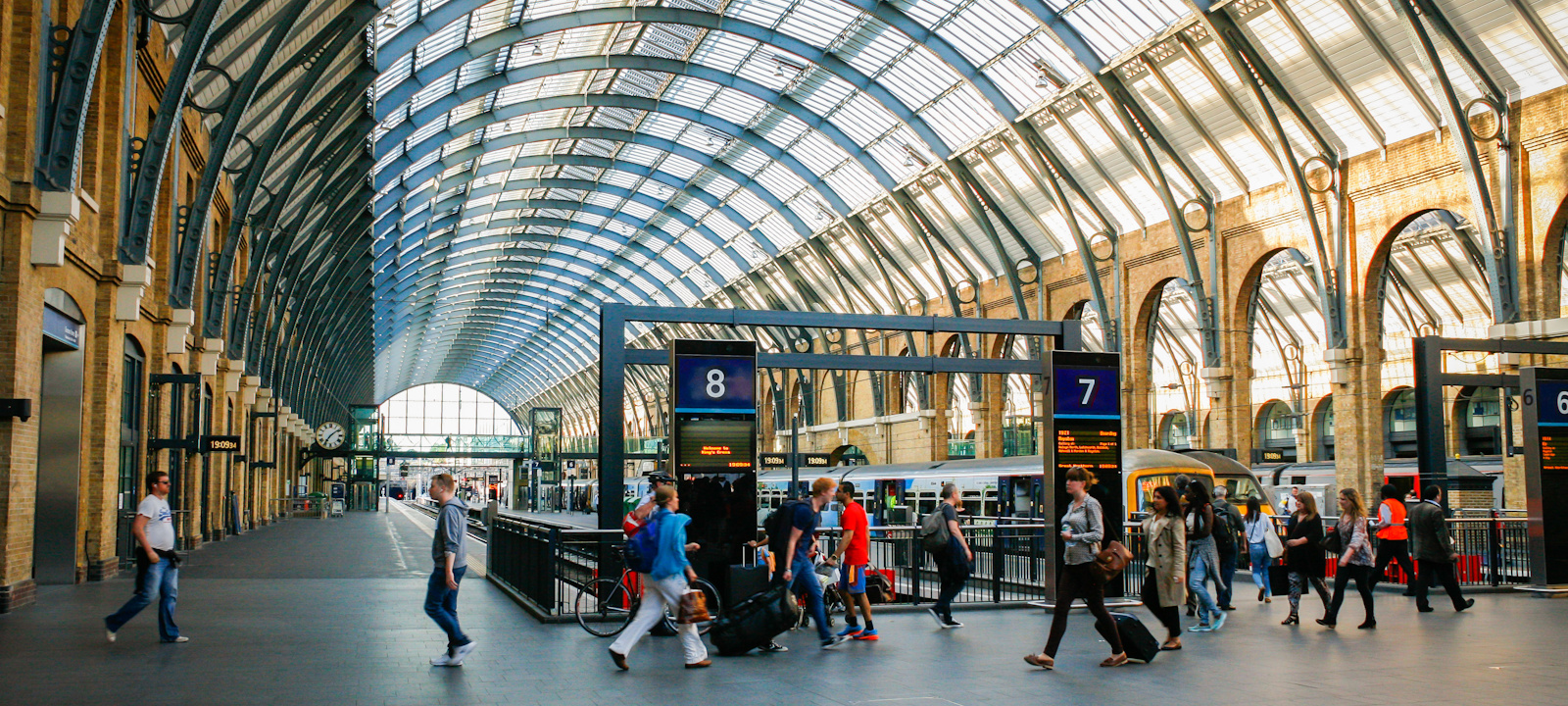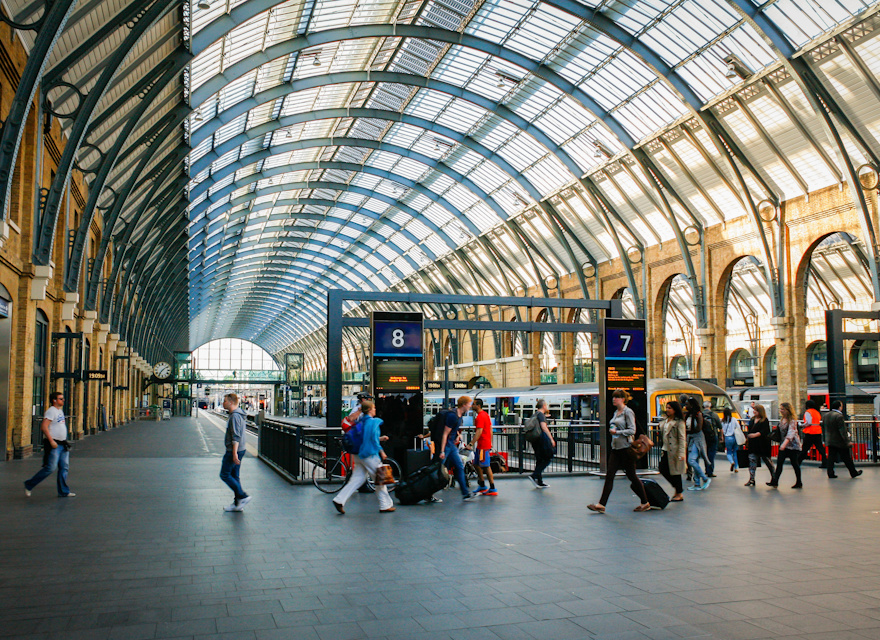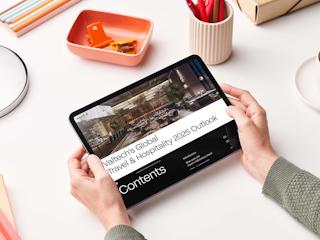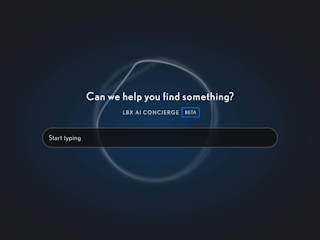Design hacks to support concepting for the blueprint delivery:

Designing for the future of rail travel
London North Eastern Railway (LNER) is one of the major train operators in the UK. Previously Virgin Trains, LNER has a rich history of innovation going back to the 1920s. Back then they became famous worldwide when they got the Flying Scotsman to hit over 100mph. Now nearly a century on, running a fleet of the new Azuma trains and stations from London to Edinburgh, LNER wants to continue to be the pacemaker for travel in the UK, leading with innovation for their customers and people. Today’s challenges include: what’s the station of the future? How do they support the customer in 2025? Where will mobility of the future be? As Adrian (Varma, Head of Digital Experience & Innovation at LNER) puts it: “Harnessing the power of converging technologies, to drive exceptional experience and remove friction and pain-points”. Let’s jump to three weeks into the project…
Diversity of thinking unlocks the design challenge
After we ran the early ideation sessions which went really well (see part 1: ideation for more info), the client direction was, OK challenge us. Here was a genuine opportunity to set the scene for a relevant future vision and a client that really wanted to be challenged. So we considered ways to scale our thinking without increasing the team. This was early lock down days too back in April, so were considering how we could run remote workshops. We decided to run an experiment: lets run remote design hacks across the LNER project to support the project team’s ideation. And not one but 5 or more across the project. We’ll run these internally and if all’s well, we’ll introduce LNER staff.
This included the fantastic San Diego team who are knee deep in the future of in-store experiences, our team from New York and our Montreal team who are very well versed in service design. Not to mention our Swedish team who know the train industry well from all their work with Scandi Express. Like any great co-design workshops, what you want is diversity of thinking: different backgrounds, different disciplines and different thoughts!
Starting from week 3, we ran weekly design hacks comprising Valtech staff from seven countries to develop future concepts the team could run through user research. By the end of the project we’d run eight design hacks with over 100 Valtechers from over seven countries. And from design hack 4 we began introducing LNER staff into the sessions. And all remote and during lockdown. And it worked well. We got a really diverse set of concepts to run through testing, to support and challenge the project team thinking and help the project outcome: just what should LNER’s digital future state look like in 2025 and beyond.
How we run design hacks
The approach that we used to run our design hacks can be summarised as follows:
-
Engagement
-
Prepare and release a story like you really want people to take part
-
Like many other organisations we have various communication channels (Slack, Workplace, Teams, even email)
-
At Valtech we run a culture where people are given autonomy to engage in activities beyond the project teams they are delivering on. So you got to grab their attention!
Internal ‘advert’ we ran on our intranet chat channels:

-
Preparation
-
Session agenda and exercises are prepped for a co-design workshop (aka design hack)
-
Project artefacts needed for the participants to reference in one place and then summarised into bite-sized chunks. For example: What are the key user pain points relevant for the session?
-
Gather everything onto a virtual wall that will be used for the workshop. We use Miro boards which have proven to be super useful for remote working
NB: Most participants of any workshop won’t read or prepare in advance (beyond a few) and that’s ok. We’re all busy people. So, prepare heavily for that first session so everyone can take part without prior knowledge. Remove the friction and make it easy for participants
-
Running the hack
-
All participants join both a conference call (we use Microsoft Teams) and an online wipe board (the Miro board) for the session
-
Set the scene for the session: purpose, agenda, expectations “you’ll work in small groups and create concepts for the future of travel based on X criteria”
-
Run through project assets e.g., customer pain points, target station layout. But don’t spend too long
-
Run priming exercise with the group to set the scene. Something simple everyone can do e.g., add your name to a post-it
-
Run a second priming exercise with the group using the project assets e.g. day in the life of target user looks like
-
Break group into smaller groups 3-5 participants
-
Run the primary workshop activities timeboxed to 10-20 minutes e.g. work up a future scenario or future concept
-
At the end of the workshop prioritise the outputs. In our case the best concepts to go forward to concepting and testing
Example priming exercise from design hack 2:

-
Rinse and repeat
-
We ironed out the kinks on the approach and scaled up
-
We got more and more staff to take part
-
We got more of the team to facilitate and run sessions
-
We covered the different themes required for us to cover e.g., station of the future and a truckload more
-
Sprint on sprint got into a flow of activities: design hack focus, run hack, prioritise for concepting, design concepts, run through user research and feedback into the sprint review. Repeat next sprint
Example of design hack outputs:

Some guidelines for running effective workshops
Regardless of whether a workshop is remote or physical, there are a number of simple patterns or guides that are useful to keep the session focused:
-
The whole workshop is split into timeboxed activities. No activity should take longer than 20 minutes
- Prepare the project assets well and clearly label things to enable participants to scan assets quickly
-
During the primary activities break the participants into smaller groups e.g., 3-5 online, 5-7 otherwise
-
Use your project team to act as facilitators to keep each of the groups on target and nudge participants
-
Get participants to present to each other - this will help them to organise their thinking on the board so they can tell a story
-
Always prioritise in every session with the whole group
-
Stop and start activities to keep participants timeboxed
Integrating design hacks into the project cadence
Running design hacks has to support the project purpose and work to the project cadence. This is somewhat of a challenge when three weeks into a project you decide to pivot and start running workshops weekly with 30+ people from across organisations. But we focused on a number of key things to integrate into the project:
-
Run the 2-hour design hack workshop at the same time each week
-
Make it super easy to take part. We use Miro boards for all session and turn project background material into a simple ‘evidence wall’ on the Miro board for participants to walk through (no one has to prep ahead)
-
Spend lots of time prepping for the first design hack - you can then easily repurpose across the rest of the design hacks
-
Every week we reached out across Valtech and secured participants. Lots of internal engagement is required so set the time aside
-
The design hacks created high level concepts and ideas - or doodles with post-its
-
The team would prioritise the concepts, visual designers would work up the concepts, ready for Monday’s user research round with customers.
-
By the next week (or sprint) we would have research and client feedback and we could reiterate
The workshops must work to the cadence of the project not the other way around. Hold to the line of the project, even when engaging senior people.
Weekly (or sprint) cadence
NB: this highlight why running Agile-based discovery projects not too tightly coupled to a project plan but truly enable your teams to pivot/alter approach three weeks in as expected not as an exception:

Benefits of running remote workshops
As mentioned earlier, we found running remote design hacks had a number of key benefits which made them very useful. This included:
-
There’s no travel requirements - participants can join from their desk at home
-
There’s no challenge securing a room to run the workshops e.g., at our office, the client’s office to hiring a space
-
And so cost is dramatically reduced to both you and the client
-
Using an online wipe-board like Miro offers you both a fairly unlimited visual space and one that teams, and clients can readily return to, pick over
-
Some people actually don’t like group-based workshops. Working remotely participants to switch off their video feed and still take part. What can seem like a barrier to some is actually a shield to others
-
Best of all: you can co-design stuff with groups of people in the same workshop (at this time up to 40 participants tested and proven)
Some of these are obvious, but a year ago we didn’t do this nearly enough.
Outcome from running the LNER design hacks
Here’s what Lydia (Creative Director UK) said straight after one of the latter sessions:
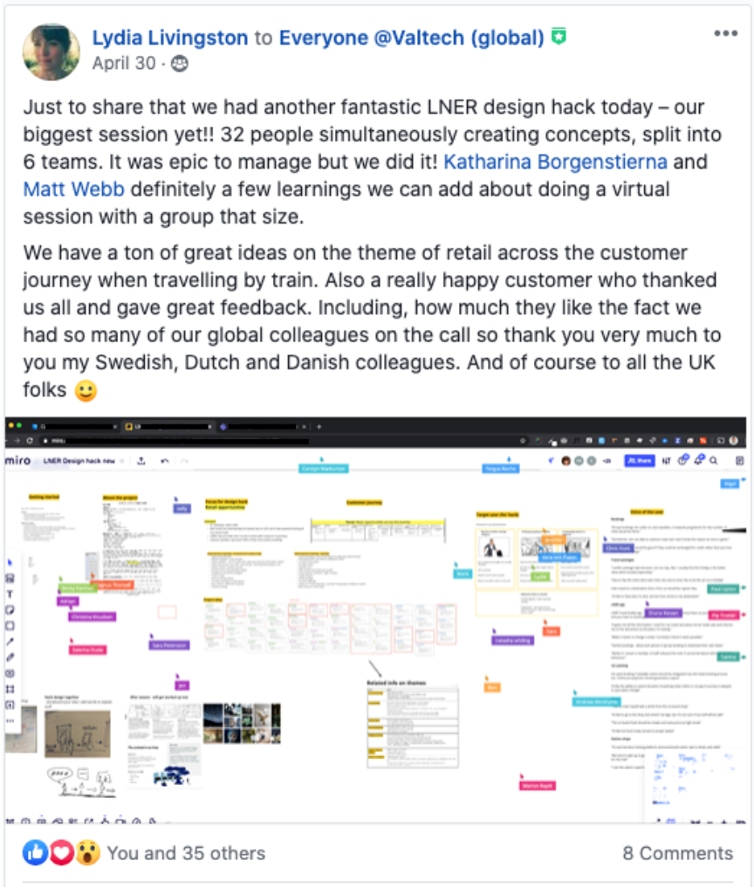
Hold up wait a minute: that’s not how we run design hacks
Not long after the project finished, we ran a community of practice day and got staff from across Valtech (many of those that had got involved in the design hacks), to present how they run co-design workshops. We’re a community of over 3000 and represent a great variety of our industry’s ways of working. But the overlap in our ways of working was obvious. For us at Valtech, the design hack term is interchangeable with co-design and can be summarised as:
-
It's making something together
-
It's co-creation
-
It's a group activity
In our world, it’s co-creating products and services and features together with teams, clients, stakeholders and with users and customers. In addition:
-
It makes design transparent. It demystifies design
-
It democratises design across groups
-
It makes design a shared experience (often with the people its for)
-
It humanises design
But it is not design by committee. It does not replace design decision-making, rather it effectively supports decision-making. Running design hacks will help you to innovate, challenge, demonstrate and engage.
Concept designs from our design hacks:
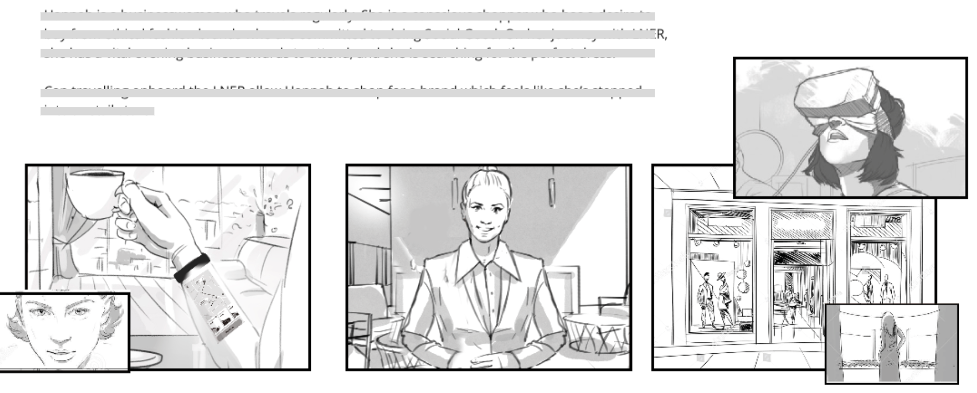
Summary
Read part 1: Bringing LNER’s future into focus to find out the aim of the project.
We’ll outline the design challenge as it unfolded early on, how we pivoted to running design hacks across the project, our approach to running these design hacks (or co-design workshops) and some of our findings on running remote creative workshops.
Read part 2: Running ideation sessions to find out how we got started.
Want to talk design hacks or running co-design workshops? Get in touch with
(this post’s author).
